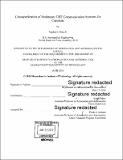| dc.contributor.advisor | Kerri Cahoy. | en_US |
| dc.contributor.author | Shea, Stephen J., Jr | en_US |
| dc.contributor.other | Massachusetts Institute of Technology. Department of Aeronautics and Astronautics. | en_US |
| dc.date.accessioned | 2016-12-05T19:56:03Z | |
| dc.date.available | 2016-12-05T19:56:03Z | |
| dc.date.copyright | 2016 | en_US |
| dc.date.issued | 2016 | en_US |
| dc.identifier.uri | http://hdl.handle.net/1721.1/105639 | |
| dc.description | Thesis: S.M., Massachusetts Institute of Technology, Department of Aeronautics and Astronautics, 2016. | en_US |
| dc.description | Cataloged from PDF version of thesis. | en_US |
| dc.description | Includes bibliographical references (pages 73-74). | en_US |
| dc.description.abstract | In this thesis we describe the process of determining the likelihood of two different Ultra High Frequency (UHF) radios damaging each other on orbit, determining how to mitigate the damage, and testing to prove the radios are protected by the mitigation. The example case is the Microwave Radiometer Technology Acceleration (MiRaTA) CubeSat. We conducted a trade study over three available radio architectures: primary radio and a beacon, high speed primary and low speed backup radios, and two fully capable radios. MiRaTA's communication architecture is a high speed primary radio and a low speed backup radio. This configuration was chosen to balance between capability and size, mass and power requirements. We present the process of redesigning the communication from its first revision with a primary radio and a beacon to a high speed primary radio and a low speed backup radio. We discuss the important factors that drive the architecture decisions and then the radio system component selections for CubeSat radios. The main factors for MiRaTA were form factor and power efficiency. The primary radio is the L-3 Cadet-U Radio and the backup radio is a MIT custom Micron Radio based on the Planet Labs Low Speed Transceiver's design. The Cadet Radio is 468 MHz and 3 MHz bandwidth for downlink and 450 MHz and 20 kHz for uplink. The Micron Radio is 401 MHz downlink, 450 MHz uplink and both signals have a bandwidth of 20 kHz. The primary and backup radios are both UHF-band, which means there is a risk of the radios damaging each other on orbit that we must factor into design and testing. After presenting the process of determining the damage thresholds of the radios and the signal strength they need to be protected from. We find that the backup radio may be at higher risk of being damaged than the primary radio, and discuss mitigation strategies. Our goal is to modify the communication system design to make sure neither radio is damaged. After reviewing the available methods of mitigations, we decided to add a limiter to the backup radio and add a high pass filter to protect the primary radio. We test the mitigation strategies on both radios. We find that with the limiter installed on the backup radio, it can be connected to a signal generator with power incremented up to 25 dBm (which is 8 dB above the damage threshold without including a limiter) without a degradation in performance. We install a filter on the primary radio's input, and demonstrate that it attenuates the backup radio's signal without degrading the primary radio's performance. We then test both radios together in a test representative of operational scenarios and find that they appear to be sufficiently protected. We discuss the success of this approach and how flight testing should be conducted as well as how it might be implemented on other CubeSats. | en_US |
| dc.description.statementofresponsibility | by Stephen J. Shea, Jr. | en_US |
| dc.format.extent | 78 pages | en_US |
| dc.language.iso | eng | en_US |
| dc.publisher | Massachusetts Institute of Technology | en_US |
| dc.rights | M.I.T. theses are protected by copyright. They may be viewed from this source for any purpose, but reproduction or distribution in any format is prohibited without written permission. See provided URL for inquiries about permission. | en_US |
| dc.rights.uri | http://dspace.mit.edu/handle/1721.1/7582 | en_US |
| dc.subject | Aeronautics and Astronautics. | en_US |
| dc.title | Characterization of redundant UHF communication systems for CubeSats | en_US |
| dc.title.alternative | Characterization of redundant Ultra High Frequency communication systems for CubeSats | en_US |
| dc.type | Thesis | en_US |
| dc.description.degree | S.M. | en_US |
| dc.contributor.department | Massachusetts Institute of Technology. Department of Aeronautics and Astronautics | |
| dc.identifier.oclc | 963837070 | en_US |
